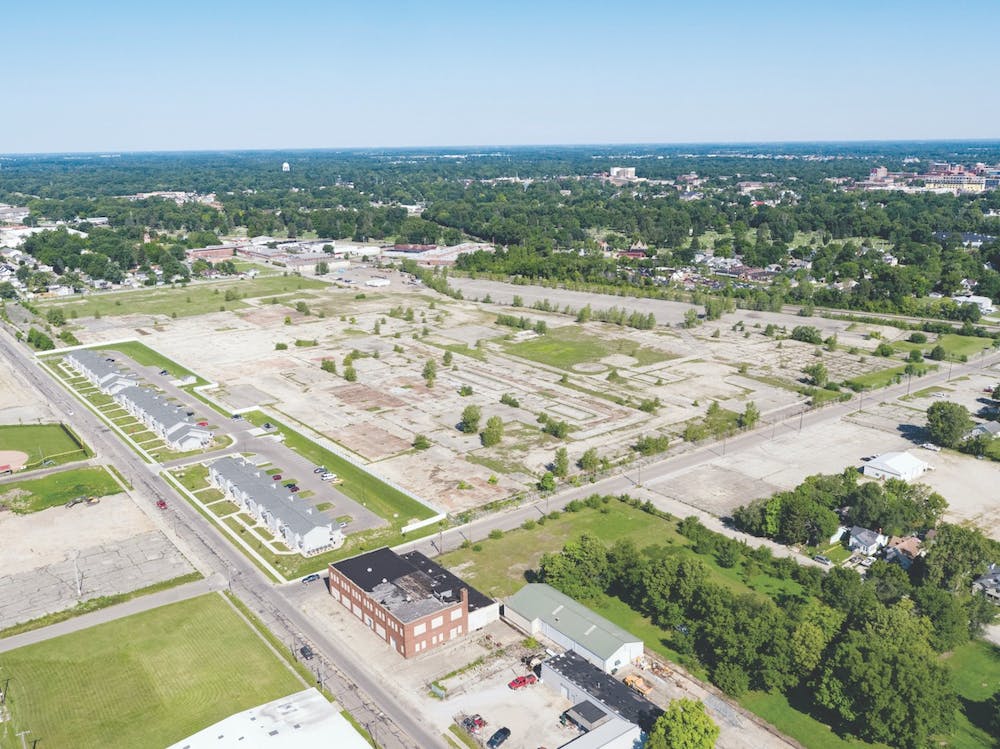How solar energy works
Solar panels convert sunlight into electrical energy through photovoltaic (PV) panels or mirrors that concentrate solar radiation.
When the sun shines on PV panels, energy from the sunlight is absorbed by the PV cells to create electrical charges that flow in a panel’s internal electric field.
The energy harnessed can be used to generate electricity or be stored in lithium batteries or thermal storage.
Source: U.S. Department of Energy
Fifty-three acres of land sit unused on 8th Street, with small patches of overgrown grass peeking out from concrete General Motors used to occupy until 2006. On Jan. 26, 2021, the City of Muncie announced it was buying this vacant property and installing a solar field.
“This property’s unique combination of size and location make it ideally suited for a project that will make Muncie a regional leader in the generation of clean, renewable energy,” Muncie Mayor Dan Ridenour said in a press release. “[This] positions our community to attract additional investment from businesses that are focused on sustainability.”
The solar field will have the capacity to generate up to 24.6 million kilowatt-hours of energy, the press release said. According to the Environmental Protection Agency, that’s enough power to supply 2,310 average American homes with electricity for one year.
The Muncie Sanitary District also plans to install solar panels at three different lift stations in Muncie, where water from sewage systems is lifted to a higher elevation to allow it to keep running downhill toward a water pollution control facility.
“We have a large one called Jake’s Creek,” said John Barlow, district administrator for the Muncie Sanitary District. “We own the parcel [of land] that it’s on, but we also own part of the unused area out there, so we’re going to be able to put a bunch of solar panels out there.”
The sanitation district will also install solar panels on Kilgore Avenue and at its new location on Martin Luther King Jr. Boulevard.
“Solar panels were the most cost-effective,” Barlow said. “They’re fairly easy to install. [There] doesn’t need to be a lot of work done on the existing infrastructure to modify it.”
Barlow said the Sanitary District has been looking into renewable energy for 15 years, but City Engineer Brian Stephens-Hotopp helped start the project in 2020. Barlow said Sanitary District employees did evaluations in 2006, but there were installation costs at the time that are no longer in place.
“He looked into this with a company called Performance Services,” Barlow said. “We determined that we had some opportunities here to really cut back electricity budgets in some of our facilities.”
Barlow said the Sanitary District is currently unsure of when the project will be completed, but the evaluations are complete.
Ball State has been using solar energy on campus since the Health Professions Building opened in November 2019.
James Lowe, associate vice president for facilities planning and management, said in an email that the university installed solar panels on the roof of the Health Professions Building and will also add panels to the Rinard Orchid Greenhouse addition, which will begin construction in April 2021 and end in the fall.
Lowe also said Ball State has used other forms of renewable energy, mainly geothermal, since March 2014. Ball State has the nation’s largest ground-source and closed-loop geothermal energy system, and the university has also planted native vegetation to replace mowed grass and is including hybrid cars in its fleet of vehicles.
“The shift has resulted in savings of over $2.5 million annually, a nearly 50 percent reduction in carbon footprint and a 100 percent reduction of other pollutions that are generated by burning coal,” he said. “This results in savings, [a] healthier environment and better quality of life.”
Installing solar panels in Muncie will encourage business development in the city, Ridenour said.
“My administration has emphasized strong, healthy neighborhoods as a building block of citywide revitalization,” Ridenour said. “With this investment, we are making clear that we are ready and willing to embrace initiatives that will benefit our residents and create a healthier environment.”
Contact Mackenzie Rupp with comments at msrupp@bsu.edu or on Twitter @kenzieer18.





